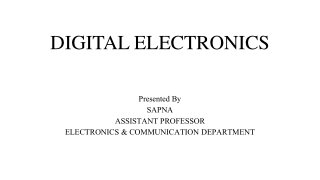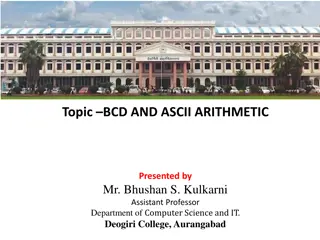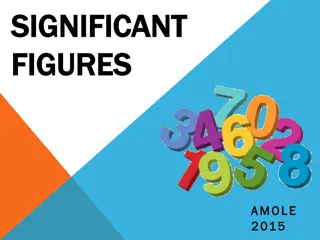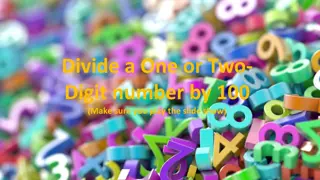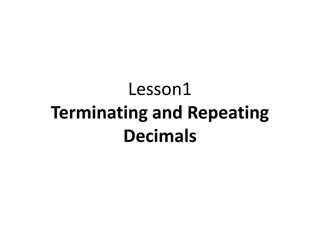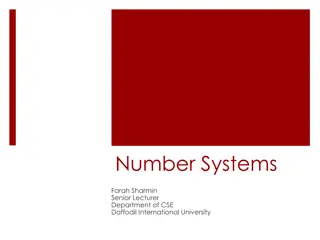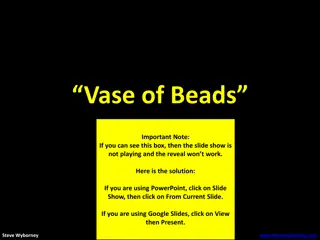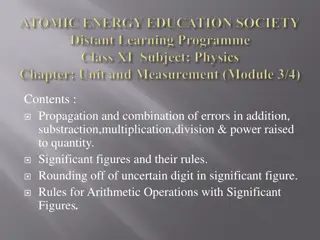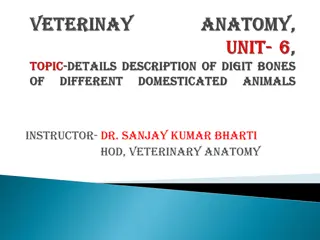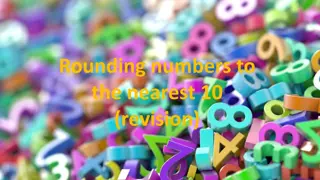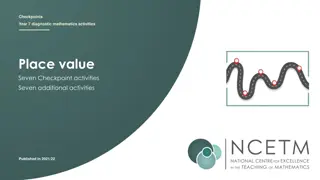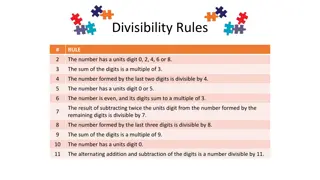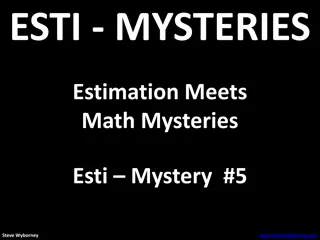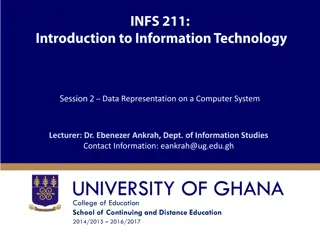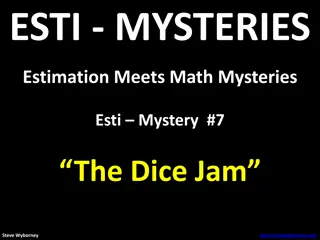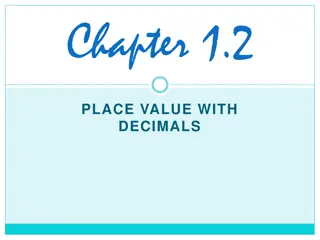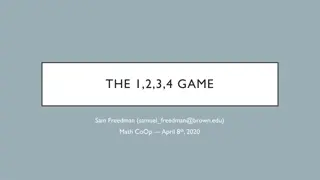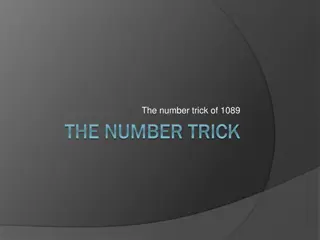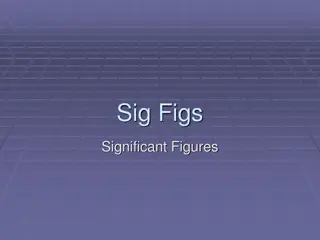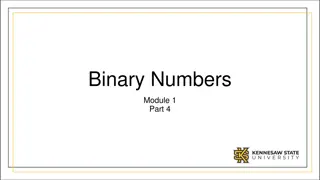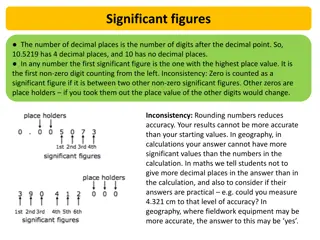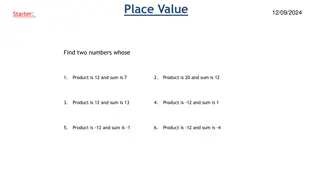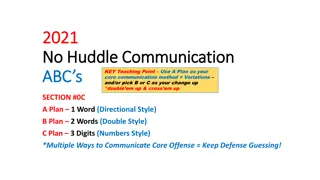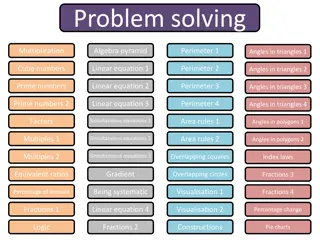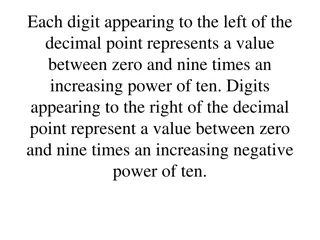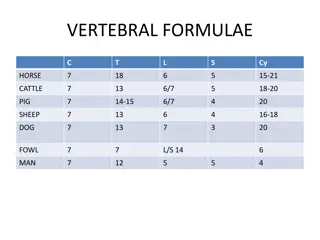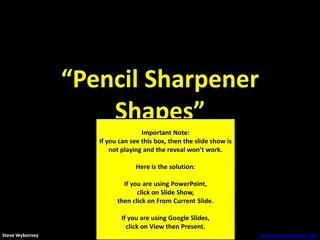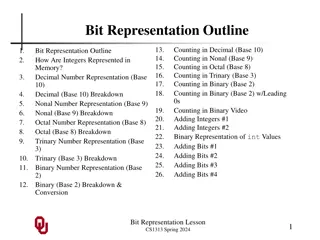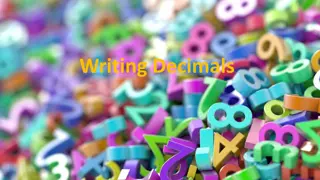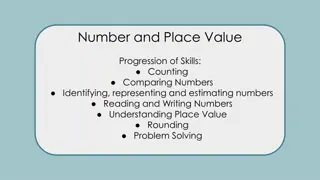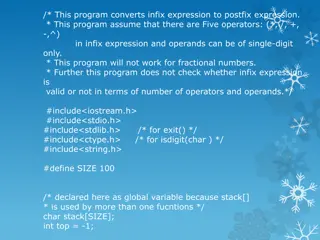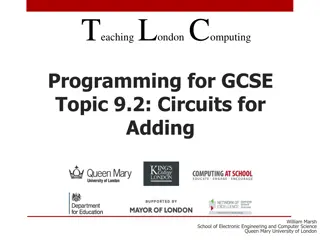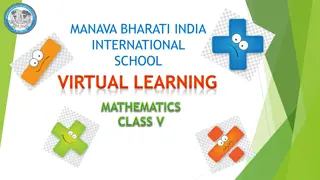Computational Physics (Lecture 18)
Neural networks explained with the example of feedforward vs. recurrent networks. Feedforward networks propagate data, while recurrent models allow loops for cascade effects. Recurrent networks are less influential but closer to the brain's function. Introduction to handwritten digit classification
0 views • 55 slides
DIGITAL ELECTRONICS
Introduction to digital electronics covering binary digits, logic levels, boolean algebra, logical operators (AND, OR, NOT), laws of boolean algebra, and operations like logical multiplication and addition. Learn about the fundamental concepts essential for understanding digital circuits and operati
0 views • 67 slides
Understanding BCD and ASCII Arithmetic in 8086 Assembly Language
BCD (Binary-Coded Decimal) and ASCII (American Standard Code for Information Interchange) are key concepts in 8086 assembly language for numerical and character manipulations. BCD Arithmetic involves addition and subtraction techniques using instructions like DAA and DAS. The adjustment instructions
1 views • 21 slides
Understanding Significant Figures in Precision Measurements
Significant figures, often referred to as Sig Figs, play a vital role in conveying the precision of measurements. They help indicate the certainty of a measurement and guide in understanding the level of accuracy. Following rules like non-zero digits being significant, trapped zeros, insignificant l
0 views • 15 slides
Understanding Division by 100: Interactive Learning Session with Grid Visualization
Explore the concept of dividing one or two-digit numbers by 100 through engaging slides that illustrate the process step by step. Practice on a grid, move digits to the right, and ensure proper placement of decimals. Reinforce learning by solving division problems on your own. Enhance understanding
0 views • 19 slides
Introduction to Terminating and Repeating Decimals
Understanding terminating decimals with a finite number of digits after the decimal point and repeating decimals with an infinite number of digits following a pattern. Learn how to convert fractions to decimals and vice versa using bar notation for repeating decimals.
0 views • 28 slides
Understanding Combinational Circuits in Computer Architecture
Combinational circuits in computer architecture play a crucial role in transforming binary information from input data to output data. These circuits consist of logic gates connected in a specific arrangement to process binary data efficiently. Key components such as half-adders and full-adders are
1 views • 48 slides
Understanding Floating Point Representation of Numbers
Floating point representation is crucial in computer arithmetic operations. It involves expressing real numbers as a mantissa and an exponent to preserve significant digits and increase the range of values stored. This normalized floating point mode allows for efficient storage and manipulation of r
0 views • 12 slides
Understanding Number Systems and Their Characteristics
Dive into the world of number systems, exploring non-positional and positional systems. Learn about the unique features of each system, including the use of symbols and digits, as well as how to convert numbers between different bases. Discover the Decimal Number System and its significance in every
2 views • 33 slides
Fun Bead Vase Math Activity: Guess the Number of Beads!
Engage in a challenging math activity where you guess the number of beads in a vase by following a series of clues and using estimation. The clues provide hints such as counting by 5s, avoiding certain digits, and more, helping you narrow down the possibilities. Test your estimation skills and see i
0 views • 15 slides
Error Propagation and Significant Figures in Arithmetic Operations
Understanding how errors propagate in addition, subtraction, multiplication, division, and raising to power operations, along with the significance of significant figures and rules for arithmetic operations involving them. Significant figures play a crucial role in determining the precision of measu
2 views • 12 slides
Overview of Veterinary Anatomy: Ox Skeletal Structure
Explore the intricate skeletal structure of an ox focusing on the digits, phalanges, and joints such as the fetlock and pastern. Dive into the detailed descriptions of the first and second phalanges, their surfaces, and articulations. Gain insights into the unique characteristics of the accessory di
1 views • 21 slides
Mastering Rounding Numbers to the Nearest 10: A Comprehensive Guide
Dive into the world of rounding numbers to the nearest 10 with this informative guide. Learn the steps to round any number, including those with multiple digits, and practice your skills with interactive examples. Discover a helpful rhyme to remember the rounding rules and explore scenarios when rou
1 views • 9 slides
Number Sequences and Rounding Practice
In this practice session, you will complete number sequences, round numbers to the nearest 10, 100, and 1,000, and work on rounding exercises. You will also differentiate between the hundreds, tens, and ones digits in numbers to round them accurately.
1 views • 14 slides
Mathematics Checkpoints and Activities for Year 7 Students
Explore a series of mathematics checkpoints and activities designed for Year 7 students, focusing on place value, comparing representations, calculations, and understanding inequalities. Engage in tasks such as arranging digits, working with multiples of 3, and understanding the value of digits in d
0 views • 22 slides
Understanding Divisibility Rules for Quick Math Solutions
Learn about various rules of divisibility such as checking if a number is divisible by 2, 3, 4, 5, 7, 8, 9, 11, and finding factors. Explore examples like forming multiples of 4 with digits 2, 4, 6, and 8, determining the number of zeros in factorials, and finding the greatest number dividing six co
1 views • 4 slides
Esti Mysteries: Bead Jar Estimation Challenge
Challenge your estimation skills with the Bead Jar Estimation Mystery #5 presented by Steve Wyborney. By analyzing clues such as the digits, odd number status, and divisibility hints, deduce the correct answer from the given set of possibilities. Sharpen your math intuition and logical thinking to s
0 views • 6 slides
Understanding Data Representation on Computer Systems
Explore how data is converted into binary forms in computer systems, the difference between data and information, binary coding schemes, and the elements of the data hierarchy. Learn about binary digits, bites, bytes, and the essential topics covered in this educational session. Recommended reading
3 views • 25 slides
Esti Mysteries: The Dice Jam - Solve the Puzzle of Hidden Dice Counts
Solve the mystery of the hidden dice counts by analyzing clues such as visible digits, odd numbers, and specific face sums. Combine estimation skills with the hints to reveal the answer: 47 dice. Enjoy this engaging math challenge designed by Steve Wyborney.
0 views • 6 slides
Understanding Decimals: Place Value and Reading Practice
Learn about decimal place value, types of decimals, how to read decimals, understanding mixed decimals, and practicing decimal exercises, including writing decimals in words and identifying digits in place value charts.
1 views • 10 slides
Fun Math Game with Digits 1, 2, 3, 4
Engage students in a stimulating math activity where they use digits 1, 2, 3, and 4 with addition, subtraction, and multiplication operations to create various numbers. This interactive game encourages teamwork, critical thinking, and creativity in exploring mathematical concepts. Students can disco
0 views • 8 slides
The Amazing 1089 Number Trick: Impress Anyone With This Cool Math Trick!
The 1089 number trick is a fascinating mathematical puzzle that has been captivating people for centuries. By following a simple set of steps involving reverse, subtract, and add operations, you can surprise others with the magical result of 1089. This clever trick works with any three-digit number
0 views • 6 slides
Understanding Significant Figures in Measurements
Significant Figures (Sig Figs) are crucial in representing the precision of measured numbers. This concept helps in determining the accuracy of calculations based on the precision of initial measurements. Sig Figs dictate which digits are considered significant or insignificant in a number, impactin
0 views • 13 slides
Understanding Binary and Decimal Number Systems
This content explores the basics of binary and decimal number systems in a simple and engaging manner. It starts with decimal numbers, explaining how our numbering system works and progresses to binary numbers, which have only 2 digits (0 and 1). The significance of these systems in computing and ho
0 views • 27 slides
Fun Snowflake Math Challenge
Explore a fun math challenge involving snowflakes falling, odd digits, Roman numerals, and snowflake area estimation. Use clues to determine the number of snowflakes falling, decode a Roman numeral door number, and calculate snowflake areas. Play with rounding numbers and comparing snowflake quantit
0 views • 5 slides
Understanding Significant Figures in Mathematics and Science
Significant figures play a crucial role in maintaining accuracy and precision in mathematical and scientific calculations. They help in determining the level of accuracy of measurements and calculations by focusing on the number of significant digits and decimal places. Rounding rules are essential
0 views • 6 slides
Exploring Place Value and Rounding for Estimation Problems
Delve into the concepts of place value, rounding, and estimation through various scenarios and problems. Discover how to find numbers based on their product and sum, estimate bill totals to the nearest pound or pence, compare rounding techniques, and analyze the effectiveness of rounding to differen
0 views • 7 slides
Effective No-Huddle Communication Strategies for Offense in Football
Explore advanced techniques for no-huddle communication in football offense, including directional, double, and numbers styles. Learn how to keep the defense guessing with core communication methods and variations using words, digits, pointers, and themes. Enhance your play-calling with strategies l
0 views • 8 slides
Math Problem-Solving Strategies for Various Mathematical Concepts
Explore a variety of math problem-solving scenarios involving multiplication, algebra, geometry, prime numbers, cubes, linear equations, factors, simultaneous equations, and more. Engage in challenges like completing cross-number puzzles, finding the difference between prime numbers, and creatively
0 views • 45 slides
Understanding Hexadecimal Numbering System
Hexadecimal numbering system provides a compact and efficient way to represent numbers, especially in computing. It uses digits 0-9 and letters A-F to represent values from 0 to 15. Converting between decimal and hexadecimal is crucial in computing, and hexadecimal numbers are widely used in binary
0 views • 88 slides
Comparative Anatomy of Mammals: Vertebral and Skeletal Structures
Explore the variations in vertebral formulae, rib pairs, rib shaft characteristics, scapula morphology, humerus features, ulna differences, and metacarpals/digits among horse, cattle, pig, sheep, dog, and fowl. Detailed images and descriptions offer insights into the distinct skeletal structures of
0 views • 9 slides
Organic Chemistry Synthesis Lab Overview for Fall 2018
The post provides detailed information on the synthesis of 4,4-di-tert-butylbiphenyl through Friedel-Crafts Alkylation in Chemistry 318 for the Fall 2018 semester. It includes a schedule of the lab day, due dates for reports and assignments, grading criteria, pre-lab requirements, and emphasis on si
1 views • 15 slides
Estimation Challenge: How Many Pencil Sharpeners Are in the Cup?
In this estimation challenge, you are given clues to deduce the number of pencil sharpeners in a cup. By applying logic and estimation techniques, narrow down the possibilities and make your best guess. After considering clues like the answer being greater than 5 and less than 18, and certain digits
0 views • 6 slides
Understanding Integer Representation in Computer Memory
Explore the binary representation of integers in computer memory, covering decimal, nonal, octal, trinary, and binary numbering systems. Learn how integers are stored using sequences of bits and decipher the breakdown of numbers in different bases. Discover the Arabic digits in decimal representatio
0 views • 26 slides
Understanding Decimal Place Value through Visual Representation
Explore the concept of decimal place value with the help of interactive images showing numbers represented in a place value grid. Practice identifying numbers based on the value of tenths, hundredths, ones, and tens columns. Improve your understanding of decimals by visualizing and interpreting the
0 views • 16 slides
Progression of Number and Place Value Skills Across Grade Levels
Explore the progression of skills related to number and place value, including counting, comparing numbers, identifying digits, reading and writing numbers, understanding place value, rounding, and problem-solving. The curriculum spans Year 1 to Year 6, covering topics such as counting forwards and
0 views • 5 slides
Understanding Place Value and Number Magnitudes
Explore the concept of place value in numbers up to seven digits, learn how to write numbers in figures, identify digit values, find the largest and smallest numbers, order numbers, and work on rounding and comparisons. Engage in exercises like recognizing digits, writing numbers in figures, circlin
0 views • 61 slides
Program to Convert Infix Expression to Postfix Expression
This program converts an infix expression to a postfix expression. It assumes there are five operators (*, /, +, -, ^) in the infix expression and operands are single digits only. The program does not handle invalid expressions or fractions. The provided code snippet contains functions for stack ope
0 views • 9 slides
Understanding Binary Addition Circuits in Computing
Explore the concepts of half adders, full adders, and binary addition circuits used in computer systems. Learn how binary digits are represented as logic levels to perform addition operations. Dive into the working principles of half adders, truth tables, formulas, and circuit diagrams for binary ad
0 views • 15 slides
Understanding Numbers and Comparisons in Mathematics
Dive into the world of numbers with a focus on large numbers, digits, and comparisons in mathematics. Explore the significance of digits, learn rules for comparing numbers, and practice examples to enhance your understanding. Master the art of determining the smallest and greatest numbers based on t
0 views • 13 slides

